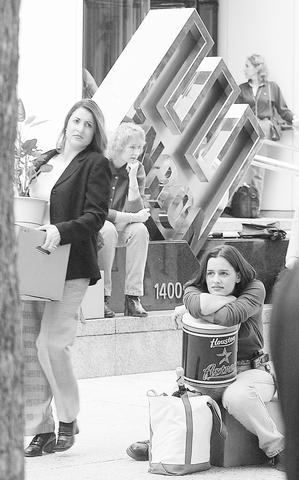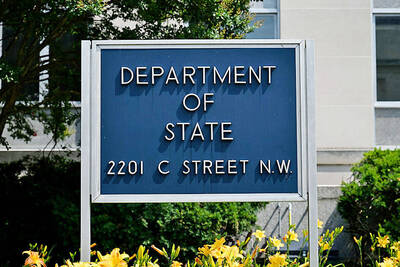Buying the dip or buying the dead? Enron Corp shares have almost quadrupled since the company filed the biggest US bankruptcy in history Sunday. The rise confounds lawyers and money managers who say the stock probably will be wiped out in a reorganization or liquidation of the Houston-based energy trader.
"That it's going up boggles my mind," said Peter Antoszyk, a partner at law firm Brown, Rudnick, Freed & Gesmer in Boston, who specializes in bankruptcy law. Enron has about US$19 billion in debt and preferred stock to repay before holders of common shares have any claim to its assets.

PHOTO: REUTERS
Buyers of Enron shares may include those who had bet on a decline and now need to replace borrowed shares to cover short sales, said traders and fund managers. Still, 700 million shares traded so far this week, more than 20 times the number that had been sold short as of last month, suggesting more buyers have been drawn into the rally.
Worthless shares have risen before during bankruptcies. In 1993, the Securities and Exchange Commission investigated trading in shares of LTV Corp and Wang Laboratories after reorganization plans left shareholders with little or nothing. On May 27, 1993, LTV shares were the most-active US stock, trading at US$0.25 a share, even though the steelmaker's bankruptcy called for the shares to be exchanged for warrants worth just US$0.03.
Enron's shares rose US$0.14 to US$1.01 on Wednesday, giving the stock a market value of more than US$750 million. Five blocks of more than 1 million shares moved after the opening, including a block of 2 million shares at US$1.03 just before the close of New York Stock Exchange trading. Last Wednesday the shares plunged 85 percent on trading of a record 346 million shares after Dynegy Inc canceled a takeover, and the shares ended the week at US$0.26.
"The stock won't be worth the paper it's printed on," said Art Hogan, chief market analyst at Jefferies & Co. He reckons Enron, which had a peak market value of more than US$70 billion last year, will be delisted from the New York Stock Exchange.
The NYSE has said it is reviewing Enron's listing on the exchange because of its Chapter 11 filing.
"The exchange monitors compliance with listing standards and it may appraise and determine on an individual basis the suitability for continued listing of an issue in light of all pertinent facts whenever it deems such action appropriate," said NYSE spokesman Ray Pellecchia.
NYSE member brokers "have a `know your customer' obligation under our rules," he said, "to know the essential facts of each customer as the basis for recommending suitable investments." Companies' annual listing fees to the Big Board are due on Jan. 1. Companies pay fees of as much as US$500,000 based on their shares outstanding. The exchange doesn't disclose how much individual members paid, Pellechia said.
With just US$500 million left to fund operations, Enron got permission from US Bankruptcy Judge Arthur Gonzalez this week to draw US$250 million of as much as US$1.5 billion in bankruptcy financing from a bank group led by JP Morgan Chase & Co and Citigroup Inc.
Former customers are shunning the company's trading operation that had generated most of its profits and helped it record US$100 billion of revenue last year. Enron fired half the 8,000 employees at its Houston headquarters and is selling units to raise cash.
Enron's debt sells for US$0.14 to US$0.28 on the dollar, indicating there won't be enough of the company left to cover creditors first in line for repayment, much less common shareholders, fund managers say.
"It looks extraordinarily doubtful there could be any value for the common shares in either a liquidation or a reorganization," said Martin Whitman, who helps manage US$4 billion at Third Avenue Funds in New York and specializes in analyzing distressed securities.
"Shareholders of the new Enron will be almost wholly the unsecured creditors. You can take that to the bank." Whitman said he may buy some of Enron's debt, but wouldn't consider the common shares.
With a minimum of a year and more likely two or more years before a reorganization plan can be worked out, buyers of Enron shares may be looking to sell within days or hoping to influence the bankruptcy talks, Antoszyk said.
Even though holders of common stock are last in line to get repaid, they must as a class approve a reorganization or liquidation plan or a judge must overturn their objection before the plan can go forward.
"The last thing you want is to go to a contested settlement plan," Antoszyk said. "You can create a mess of litigation that can be very costly and slow things up." At current prices, a controlling interest in Enron would cost about US$400 million.
Internet message boards were filled with postings by people arguing whether the rise in Enron is a "sucker's rally" or a buying opportunity.
"It could just be a lot of retail investors who think Enron at US$0.26 a share looked pretty good," said Bruce Simon, chief investment officer at Glenmede Trust, which manages US$17 billion in Baltimore. "They think they can double their money overnight, which you can." Just don't plan on holding the shares long, he said.

A car bomb killed a senior Russian general in southern Moscow yesterday morning, the latest high-profile army figure to be blown up in a blast that came just hours after Russian and Ukrainian delegates held separate talks in Miami on a plan to end the war. Kyiv has not commented on the incident, but Russian investigators said they were probing whether the blast was “linked” to “Ukrainian special forces.” The attack was similar to other assassinations of generals and pro-war figures that have either been claimed, or are widely believed to have been orchestrated, by Ukraine. Russian Lieutenant General Fanil Sarvarov, 56, head

SAFETY FIRST: Double the number of police were deployed at the Taipei Marathon, while other cities released plans to bolster public event safety Authorities across Taiwan have stepped up security measures ahead of Christmas and New Year events, following a knife and smoke bomb attack in Taipei on Friday that left four people dead and 11 injured. In a bid to prevent potential copycat incidents, police deployments have been expanded for large gatherings, transport hubs, and other crowded public spaces, according to official statements from police and city authorities. Taipei Mayor Chiang Wan-an (蔣萬安) said the city has “comprehensively raised security readiness” in crowded areas, increased police deployments with armed officers, and intensified patrols during weekends and nighttime hours. For large-scale events, security checkpoints and explosives

PUBLIC SAFETY: The premier said that security would be tightened in transport hubs, while President Lai commended the public for their bravery The government is to deploy more police, including rapid response units, in crowded public areas to ensure a swift response to any threats, President William Lai (賴清德) said yesterday after a knife attack killed three people and injured 11 in Taipei the previous day. Lai made the remarks following a briefing by the National Police Agency on the progress of the investigation, saying that the attack underscored the importance of cooperation in public security between the central and local governments. The attack unfolded in the early evening on Friday around Taipei Main Station’s M7 exit and later near the Taipei MRT’s Zhongshan

REBUFFED: In response to Chinese criticism over recent arms sales, Washington urged Beijing to engage in meaningful dialogue instead of threats and intimidation Washington’s long-term commitment to Taiwan would not change, the US Department of State said yesterday, urging Beijing to stop pressuring Taiwan and engage in meaningful bilateral dialogues. The remarks came in response to a backlash from Beijing about Washington’s latest approval of arms sales to Taiwan. The US Defense Security Cooperation Agency said in a statement on Wednesday that the Taipei Economic and Cultural Representative Office in the US has asked to purchase an arms package, including Tactical Mission Network Software; AH-1W helicopter spare and repair parts; M109A7 self-propelled howitzers; HIMARS long range precision strike systems; tube-launched, optically tracked, wire-guided missiles; Javelin